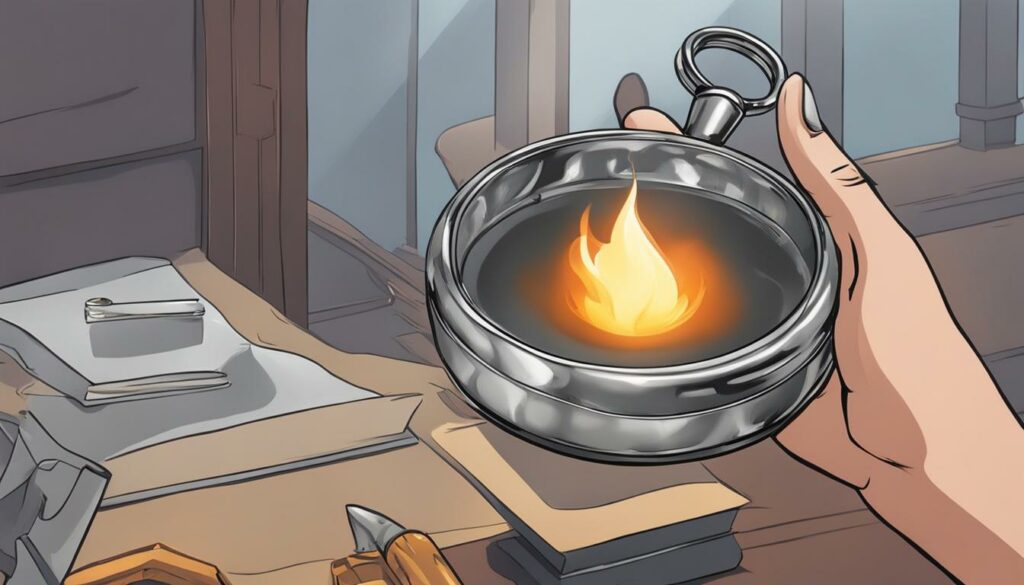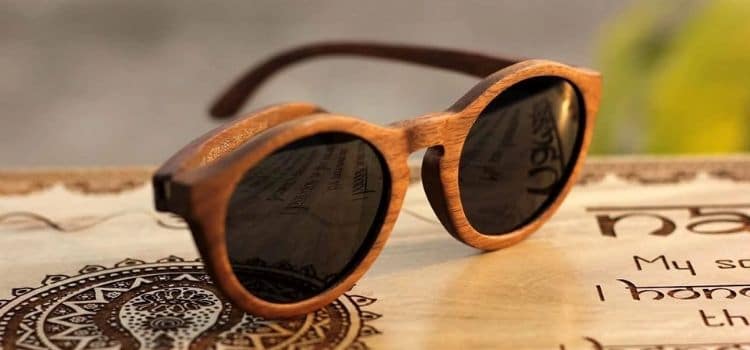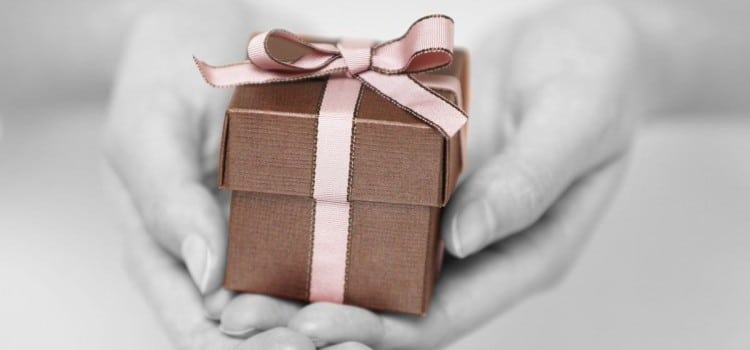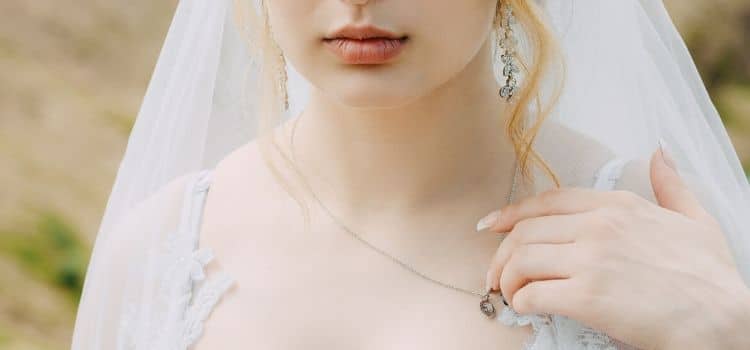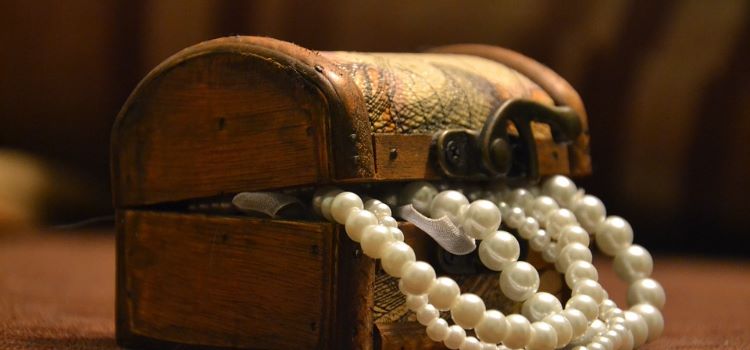Are you wondering whether your silver jewelry is real or fake? As a non-expert in metals, it can be challenging to determine the authenticity of silver. But worry not! I’m here to share with you a simple and effective method to find out if your silver is real – using a lighter.
Silver is a precious metal that has been used in jewelry for centuries. Its value and allure make it a popular choice, but distinguishing between real and fake silver can be tricky. That’s why using a lighter can provide valuable insights to help you make an informed decision about your silver jewelry.
In this article, I will guide you through the process of identifying real silver using a lighter. We will explore other tests, such as the ice cube test and the bleach test, to ensure you have all the tools necessary to determine the authenticity of your silver.
So, let’s dive in and discover the secrets to telling if your silver is real with a lighter!
The History and Types of Silver in Jewelry
Silver has a fascinating history as a precious metal that spans thousands of years. It has been used in jewelry and decorative pieces since ancient times, prized for its beauty and versatility. Today, silver jewelry remains popular, and there are various types of silver used in its creation.
Fine silver is the purest form of silver and contains 99.9% silver content. It is often too soft to be used in jewelry on its own and is commonly alloyed with other metals to increase its durability.
Sterling silver is a popular choice for jewelry, especially in the United States and Europe. It is made up of 92.5% silver and 7.5% copper, which provides strength and durability to the metal.
Argentium silver is a modern variation of sterling silver that contains a higher percentage of pure silver. It is known for its superior tarnish resistance and is a preferred choice for those looking for low-maintenance silver jewelry.
Coin silver is made from recycled silver coins and typically contains 90% silver. It is essential to note that coin silver may have impurities from the coins it was made from, affecting its purity.
Silver-plated jewelry consists of a base metal, such as brass or copper, with a thin layer of silver plated on top. While it may look like silver, it is not solid silver and will eventually wear off.
Understanding the different types of silver used in jewelry is crucial when it comes to determining the authenticity of silver pieces. Each type has its own characteristics and levels of purity, which can impact its value and durability.
The Variety of Silver Jewelry
Aside from the types of silver, there is also a wide range of jewelry styles and designs to explore. From classic silver necklaces and earrings to intricate silver bracelets and rings, there is something for everyone’s taste and preference.
Here are some popular styles of silver jewelry:
- Silver pendants and necklaces
- Silver hoop and stud earrings
- Silver bangles and cuffs
- Silver rings in various designs
- Silver anklets and toe rings
Each style offers its own unique charm and can be worn for various occasions, from casual to formal. Whether you prefer minimalist designs or statement pieces, silver jewelry allows for endless possibilities in self-expression.
“Silver jewelry has a timeless appeal, with its lustrous shine and versatility. It is not only a fashion statement but also a way to carry a piece of history and tradition with you.”
As you explore the world of silver jewelry, it is important to be able to identify and appreciate its authenticity. By understanding the history and types of silver used in jewelry, you can make informed decisions when purchasing silver pieces and ensure their lasting beauty and value.
The Importance of Authentic Silver
Authentic silver holds significant value in the market, both monetarily and aesthetically. Knowing if your silver is real is important, especially for those with allergies or sensitivities to other metals. Wearing fake silver can cause skin irritation and discomfort, while real silver can be worn without any issues.
Real silver not only adds a touch of elegance to your jewelry collection but also serves as a valuable asset. Its intrinsic worth lies in its rarity and desirability. Whether you are looking to wear silver for its aesthetic appeal or consider it as an investment, knowing the value of real silver is crucial.
Fake silver, on the other hand, can pose risks to your health. Many fake silver items are made of other metals or are silver-plated, which can cause allergic reactions and skin irritations. Protecting yourself from these risks starts with being able to distinguish between real and fake silver.
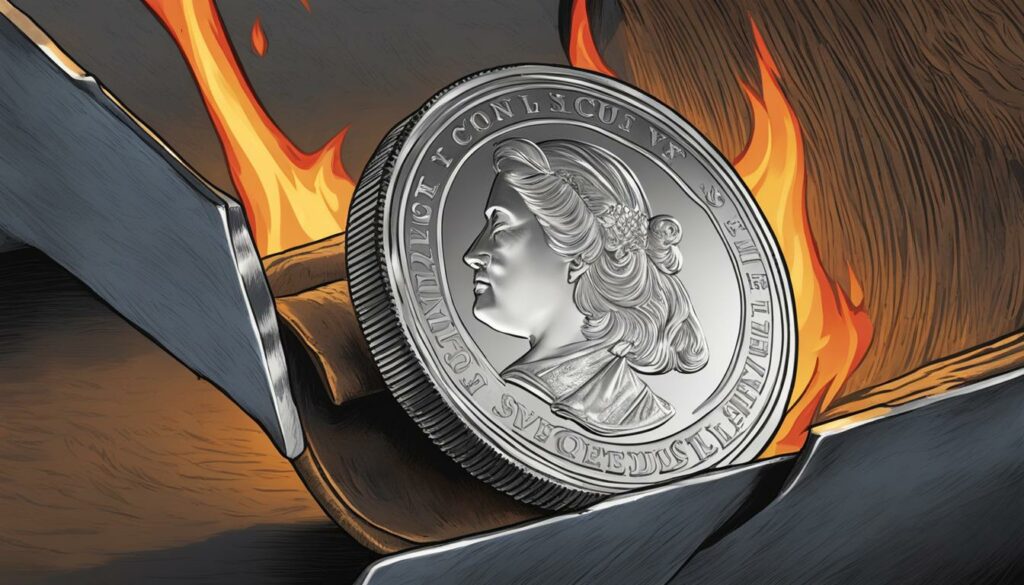
By ensuring that your silver is authentic, you can avoid the discomfort and potential health hazards associated with fake silver. In the following sections, we will explore various methods and tests that you can use to determine the authenticity of your silver, including examining stamps and markings, using magnets, conducting the ice cube test, and more. Stay tuned to discover how you can confidently identify real silver and make informed decisions when it comes to buying or selling silver items.
Identifying Real Silver with Stamps and Markings
One way to determine if your silver is real is by examining the stamps, engravings, or markings on the piece. These marks can provide valuable information about the authenticity and purity of the silver. Here are some common stamps and hallmarks to look out for:
| Stamp/Marking | Description |
|---|---|
| 925 | This stamp indicates that the silver is sterling silver, which consists of 92.5% pure silver and 7.5% of other metals. |
| 900 | A stamp of 900 signifies that the silver is 90% pure silver and 10% alloy. It is commonly used in antique silver items. |
| 800 | This stamp indicates that the silver is 80% pure silver and 20% alloy. It is commonly found in silver items from certain European countries. |
| Hallmarks | Various countries have their own hallmarks to indicate the authenticity of silver. For example, “STER” is often used to signify sterling silver, while “IS” is an international silver hallmark. |
It’s important to note that not all silver items may have visible stamps or hallmarks. Some older or handmade pieces may not be marked, and it doesn’t necessarily mean they are not authentic. However, the presence of these stamps and hallmarks can provide added assurance of the silver’s authenticity.
When examining the stamps and markings, look for clear and well-defined engravings. If the markings appear blurry, faint, or inconsistent, it may be a sign of a fake or low-quality silver item. Additionally, pay attention to any additional words or symbols that may accompany the stamps, as they can provide further information about the silver’s origin, manufacturer, or date of production.
Remember, while examining stamps and markings can be a useful method to determine if your silver is real, it is not foolproof. Some counterfeit items may also bear fake stamps, so it’s essential to consider other tests and consult experts if you have any doubts about the authenticity of your silver jewelry or items.
Testing with a Magnet
One simple and effective method to determine if your silver is real is by testing its magnetic properties. Unlike metals like iron or nickel, silver is not noticeably magnetic. By using a magnet, you can quickly assess the authenticity of your silver.
To conduct the test, hold a magnet close to your silver piece. If the magnet sticks strongly to the silver, it is likely not real silver. Genuine silver has minimal magnetic attraction, so if you feel a strong pull or the magnet sticks firmly, it indicates that the item is made of a different metal or is silver-plated.
This test can be especially useful when you’re examining items such as jewelry, coins, or silverware. Remember to use a strong magnet for accurate results. If you don’t have a magnet readily available, you can purchase one from a hardware store or online.
| Test | Result |
|---|---|
| Magnet sticks strongly | Not real silver |
| Magnet has minimal attraction | Likely real silver |
Using a magnet to test the authenticity of your silver is a quick and straightforward method. However, it’s important to note that this test should be used in conjunction with other tests, as some counterfeiters have found ways to create non-magnetic fake silver. If you’re unsure about the results or have valuable silver items, consulting a professional jeweler or silver appraiser is recommended to get an accurate assessment.
The Ice Cube Test
One simple and effective method to determine the authenticity of silver is the ice cube test. This test takes advantage of silver’s high thermal conductivity, which means it conducts heat quickly. To perform the ice cube test, you will need an ice cube and a flat surface made of glass or ceramic.
Place the ice cube on the surface of the silver item you want to test. Observe how the ice cube behaves when in contact with the silver. If the silver is genuine, the ice cube will start melting rapidly due to the silver’s superior heat-conducting properties. However, if the ice cube melts slowly or doesn’t melt at all, it may indicate that the silver is not authentic.
The ice cube test is a quick and easy way to assess the thermal conductivity of silver and determine its authenticity. However, it is important to note that this test is not foolproof and should be used in conjunction with other methods for a more accurate evaluation of silver’s authenticity.
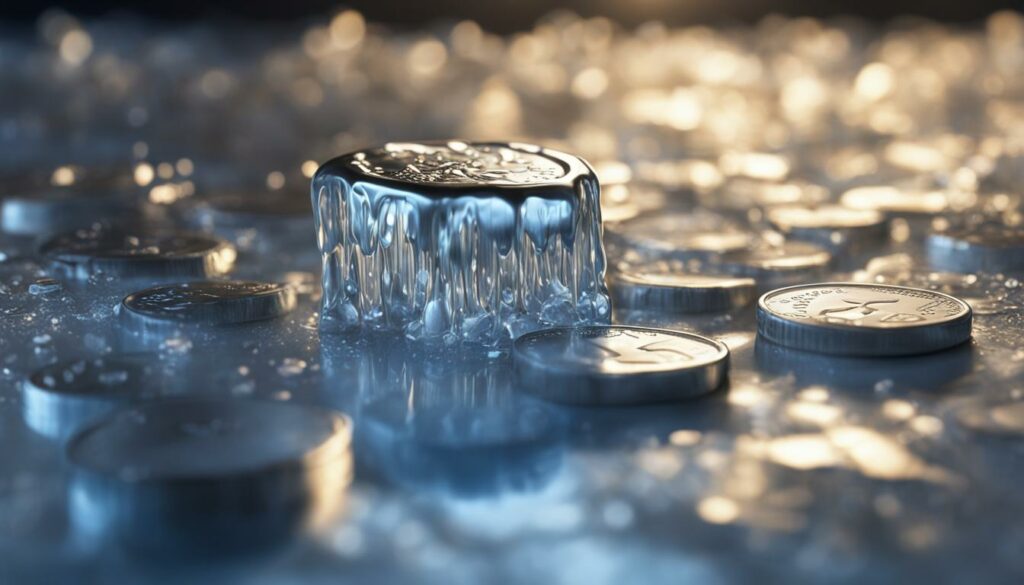
| Test Method | Advantages | Disadvantages |
|---|---|---|
| The Magnet Test | Simple and inexpensive | Not conclusive as some counterfeit silver may not be magnetic |
| The Bleach Test | Quick and easy | May damage silver if performed incorrectly |
| The Sound Test | Can provide additional evidence of authenticity | Subjective and requires experience |
| The Acid Test | Highly accurate in determining silver purity | Requires special chemicals and expertise |
| The Ice Cube Test | Simple and requires no specialized tools | Not 100% conclusive and should be used in conjunction with other methods |
The table highlights the advantages and disadvantages of different silver authenticity tests. It is important to consider multiple test methods to obtain a more comprehensive evaluation of silver’s authenticity. Remember, if you are unsure about the authenticity of your silver, it is best to consult with a professional jeweler or silver appraiser for an accurate assessment.
The Bleach Test
One simple and effective test to determine the authenticity of your silver is the bleach test. This test involves applying a small drop of bleach to the silver item and observing its reaction. Authentic silver will tarnish or turn black when exposed to bleach, while fake silver or silver-plated items may not have the same reaction.
The bleach test works because silver reacts with bleach due to the chemical makeup of the metal. The tarnishing or blackening occurs as a result of a chemical reaction between the silver and the chlorine present in bleach. This reaction does not occur with fake silver, as it is typically made of other metals or coated with a thin layer of silver.
“The bleach test is a reliable method to determine if your silver is real or fake. It is important to note that this test should be done with caution and only on a small inconspicuous area of the silver item.”
To perform the bleach test, follow these steps:
- Choose a small area on the silver item where the bleach can be applied.
- Apply a small drop of bleach to the chosen area.
- Observe the reaction of the silver to the bleach. If the silver tarnishes or turns black, it is likely authentic. If there is no reaction or the silver remains unchanged, it may be fake silver.
Keep in mind that the bleach test may cause permanent damage to the silver item, particularly if it is a valuable or antique piece. It is always recommended to consult a professional or expert if you have any doubts about the authenticity of your silver.
| Pros of the Bleach Test | Cons of the Bleach Test |
|---|---|
| Simple and easy to perform | Potential damage to the silver item |
| Can provide a quick indication of authenticity | May not be suitable for valuable or antique pieces |
| Relatively low cost | Requires caution and care |
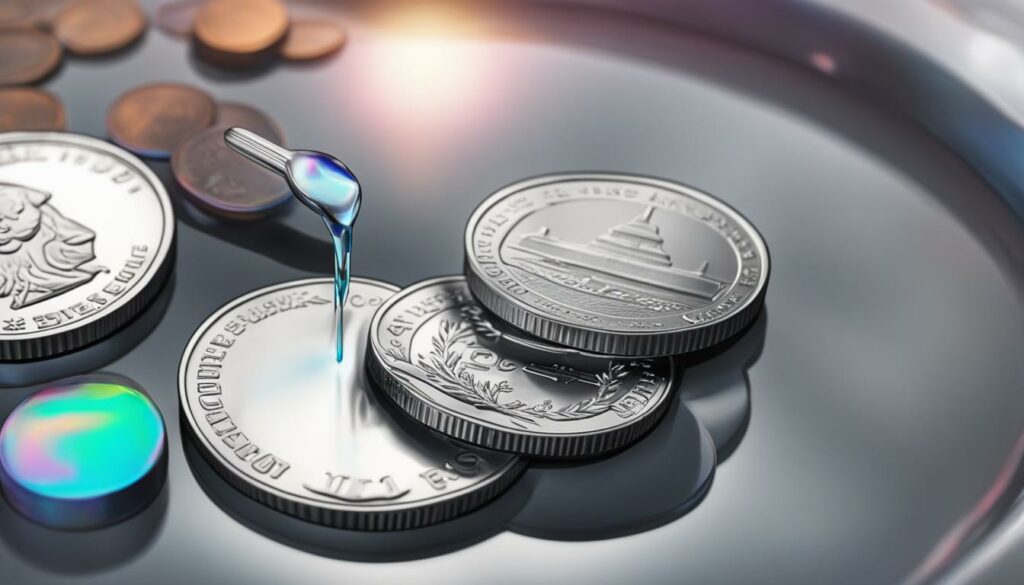
Remember, the bleach test is just one of several methods to determine if your silver is real or fake. It is always recommended to combine multiple tests and consult experts for a comprehensive evaluation of the authenticity of your silver items.
Other Tests for Silver Authenticity
In addition to the magnet, ice cube, and bleach tests, there are other methods you can use to determine if your silver is real. These tests can provide further confirmation of the authenticity of your silver items. Two popular tests are the sound test and the acid test.
The Sound Test
The sound test involves tapping the silver item and listening for a distinct ringing sound. Real silver tends to produce a clear, bell-like ring, while fake silver may sound dull or muffled. To perform this test, hold the silver item by the edge and gently tap it with a metal object, such as a spoon or another piece of silver. Listen closely to the sound it produces. If you hear a vibrant, high-pitched ring, it is a good indication that the silver is authentic.
The Acid Test
The acid test is a more advanced method that requires the use of a silver acid test kit. This test helps determine the purity of the silver by examining its reaction to specific acids. The kit typically contains a series of acid solutions with different strengths, ranging from mild to strong. To perform the acid test, you will need to apply a small drop of acid solution to a discrete area on the silver item. Observe any changes in color or texture that occur. Genuine silver will not react or show any discoloration, while fake silver may exhibit signs of tarnishing or discoloration. It is important to follow the instructions provided with the acid test kit and take necessary precautions when handling acids.
By utilizing these additional tests, you can gather more evidence to support the authenticity of your silver items. However, it is crucial to note that conducting these tests should be done with care and caution. If you are unsure or uncomfortable performing these tests on your own, it is always advisable to seek assistance from professionals who specialize in silver appraisals and authenticity assessments.
| Test | Method | Result |
|---|---|---|
| Magnet Test | Hold a magnet close to the silver. If the magnet sticks strongly, the silver is likely not real. | No attraction or weak attraction indicates authentic silver. |
| Ice Cube Test | Place an ice cube on the silver. If it melts rapidly, it is a good indication that the silver is authentic. | Rapid melting suggests genuine silver. |
| Bleach Test | Apply a drop of bleach to the silver. Authentic silver will tarnish or turn black. | Tarnishing or blackening confirms real silver. |
| Sound Test | Tap the silver item and listen for a bell-like ringing sound. Real silver produces a vibrant, high-pitched ring. | A clear, bell-like ring suggests authentic silver. |
| Acid Test | Apply acid solution from a silver acid test kit to the silver. Genuine silver will not react or show any discoloration. | No reaction or discoloration indicates real silver. |
Tips for Buying Authentic Silver
When it comes to buying silver, it’s essential to ensure that you’re getting the real deal. With so many options and sellers out there, it can be challenging to navigate the market and make the right choice. Here are some tips to help you buy authentic silver and find trustworthy sources:
- Research the Seller: Before making a purchase, take the time to research the seller. Look for well-established jewelers or reputable online stores that specialize in silver jewelry. Check customer reviews and ratings to get an idea of their credibility. Avoid buying from unknown or suspicious sellers, especially those without any online presence or customer feedback.
- Ask for Certifications: Trustworthy sellers often provide certifications of authenticity for their silver items. Look for certifications from recognized institutions or hallmarking organizations that guarantee the quality and purity of the silver. These certifications act as a stamp of approval, giving you confidence in your purchase.
- Examine the Markings: Real silver items usually have markings or stamps that indicate their authenticity. Look for stamps, such as “925” or “Sterling,” which signify that the piece is made of at least 92.5% pure silver. Additionally, check for other hallmarks or manufacturer’s marks that can provide further information about the silver’s origin and quality.
- Consider the Price: While it’s true that genuine silver comes at a price, be cautious of suspiciously low prices. If a seller is offering silver items at significantly discounted rates, it may be a red flag for fake or low-quality silver. Compare prices from different sellers and ensure that the price aligns with the market value of silver.
By following these tips, you can increase your chances of buying authentic silver from trusted sources. Remember to do your due diligence, ask questions, and seek professional advice if needed. Purchasing genuine silver not only ensures that you’re getting a valuable and durable piece, but it also eliminates the risks associated with fake or counterfeit silver.
| Trustworthy Sources for Silver | Pros | Cons |
|---|---|---|
| Jewelry Stores | – Wide range of silver options – Expert assistance and guidance – Certifications and guarantees – Ability to physically examine the silver |
– Higher price range – Limited availability of unique or rare pieces – Potential for inflated prices in some stores |
| Online Retailers | – Convenient shopping from home – Access to a global marketplace – Wide selection of designs and styles – Competitive pricing |
– Need to rely on product descriptions and images – Difficulty in physically examining the silver – Potential for fraudulent sellers or counterfeit items |
| Auction Houses | – Opportunity to find rare or unique silver pieces – Potential for competitive bidding and good deals – Access to expert appraisers and authenticators |
– Limited availability of auctions – Often higher prices due to auction fees – Need for thorough research on the authenticity of items |
Buying authentic silver is not only about the value of the piece but also about the trust and confidence you have in your purchase. Take your time, educate yourself about silver, and choose sellers who prioritize transparency and quality. By investing in authentic silver, you can enjoy the beauty and longevity of this precious metal for years to come.

Caring for Your Silver
Proper care and maintenance are essential for keeping your silver in good condition and preventing tarnish. Here are some tips to help you maintain the beauty of your silver jewelry and items:
- Regular Cleaning: Clean your silver regularly to remove dirt, oils, and tarnish. Use a soft cloth or a silver polishing cloth to gently wipe the surface of the silver. Avoid using abrasive materials or harsh chemicals that can damage the silver.
- Storage: Store your silver jewelry in a cool, dry place to minimize exposure to moisture and humidity. You can use anti-tarnish bags or cloths to prevent tarnish and slow down the oxidation process.
- Avoid Contact with Chemicals: Avoid exposing your silver to harsh chemicals, such as bleach, chlorine, or ammonia, as these can cause damage and tarnish. Take off your silver jewelry before swimming in chlorinated pools or using household cleaning agents.
- Wear with Care: Be mindful of how you wear your silver jewelry. Avoid wearing silver pieces while engaging in activities that may cause scratches or damage, such as sports or heavy-duty tasks. Remove your silver jewelry before applying lotion, perfume, or any other beauty products.
By following these simple care tips, you can extend the life and beauty of your silver jewelry and items, preventing tarnish and keeping them looking their best.
| Cleaning Method | Pros | Cons |
|---|---|---|
| Using a Silver Polishing Cloth | – Gentle and effective – Removes tarnish and restores shine – Easy to use |
– May not be suitable for heavily tarnished items – Not for delicate or gemstone-adorned pieces |
| Warm Soapy Water | – Safe for most silver items – Removes dirt and oils – Requires minimal tools |
– Not recommended for pieces with delicate gemstones or pearls |
| Baking Soda and Aluminum Foil | – Removes heavy tarnish – Requires common household items |
– May cause abrasion on delicate silver surfaces – Not suitable for gemstones or pearls |
“Taking proper care of your silver not only keeps it looking beautiful but also prevents tarnish and extends its lifespan. Remember to store it properly, clean it regularly, and avoid exposing it to harsh chemicals. With a little effort, your silver will continue to shine and bring joy for years to come.”
Recognizing the Value of Real Silver
When it comes to silver, authenticity holds significant value. Genuine silver is not just a beautiful accessory; it can also be a smart investment. Understanding the worth and desirability of real silver can guide your decisions when buying or selling silver items.
Investing in real silver can provide long-term benefits. Unlike fake silver or silver-plated items, authentic silver maintains its value over time. As a precious metal, it is respected in the market and can offer stability in uncertain economic times. Whether you choose to wear your silver or keep it stored for the future, its monetary value remains intact.
Real silver is also highly durable, making it a practical choice for jewelry and other items. Unlike cheaper imitations, genuine silver can withstand regular wear and tear without losing its shine or luster. It can be passed down through generations, maintaining its beauty and value for years to come.
| Benefits of Real Silver | Investment in Silver |
|---|---|
| 1. Long-term monetary value | 1. Stability in the market |
| 2. Durability | 2. Respected precious metal |
| 3. Timeless beauty | 3. Preservation of value |
As you consider the value of real silver, it’s essential to make informed decisions. Research credible sources, such as reputable jewelers, to ensure you’re purchasing authentic silver. Look for certifications or guarantees of authenticity to have peace of mind when investing in silver items. By recognizing the worth of real silver, you can enjoy its beauty and reap the rewards of a valuable asset.
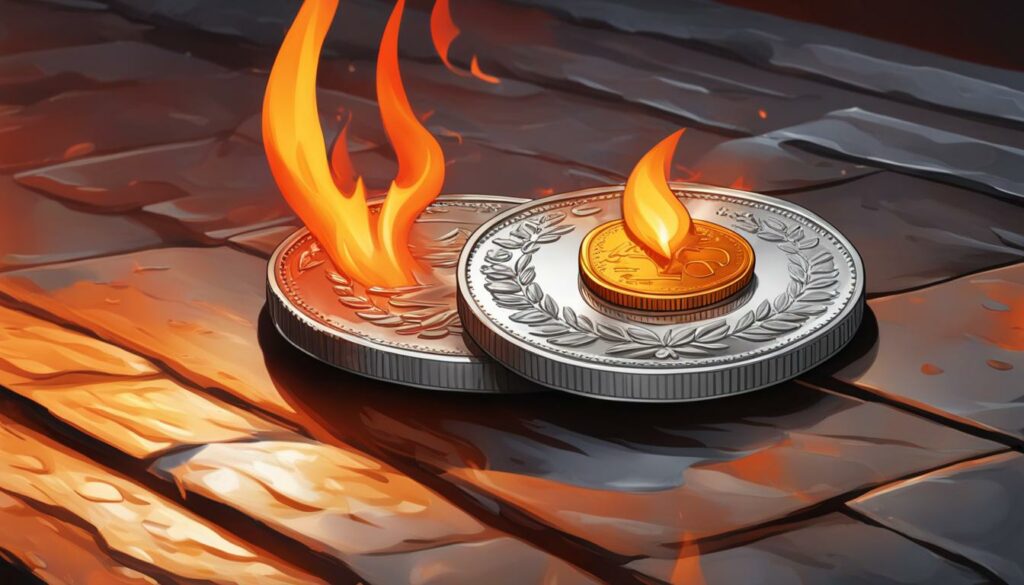
Fake Silver and its Risks
When it comes to silver, not all that glimmers is real. Fake silver, often made of other metals or silver-plated, can pose risks to those who are allergic or sensitive to certain metals. Wearing fake silver can cause skin irritation, rashes, and discomfort. It is important to be able to distinguish between real and fake silver to avoid these risks.
One of the main risks of fake silver is allergic reactions. Many fake silver pieces are made with base metals such as nickel or copper, which can cause allergic reactions in some people. These reactions may include itching, redness, and inflammation of the skin. It is crucial for individuals with known metal allergies to be aware of the authenticity of their silver jewelry to prevent these allergic reactions.
Wearing fake silver can cause skin irritation, rashes, and discomfort.
In addition to allergic reactions, fake silver is also prone to tarnishing. Unlike real silver, which develops a natural patina over time, fake silver often tarnishes quickly and unevenly. This can result in a dull and discolored appearance, making the fake silver piece lose its aesthetic appeal. It is important to be aware of the quality of your silver to ensure it maintains its beauty and value.
By understanding the risks associated with fake silver, you can make informed decisions when purchasing and wearing silver jewelry. It is essential to be able to identify real silver using methods such as testing with a magnet, the ice cube test, or the bleach test, as mentioned in earlier sections. Investing in authentic silver not only protects you from potential allergic reactions but also ensures you are wearing a high-quality and long-lasting piece of jewelry.
The Risks of Fake Silver
1. Allergic reactions: Fake silver pieces may contain base metals that can trigger skin allergies and cause discomfort, itching, redness, and inflammation.
2. Tarnishing: Fake silver is prone to tarnish quickly and develop an uneven, discolored appearance, diminishing its aesthetic appeal.
3. Potential loss of value: Fake silver has little to no resale value and may not hold up well over time.
4. Skin irritation: Wearing fake silver can cause skin irritation, rashes, and discomfort due to the lower quality of materials used.
5. Misrepresentation: Buying fake silver unknowingly may result in purchasing a product that is misrepresented in terms of its value and authenticity.
| Risks of Fake Silver | Consequences |
|---|---|
| Allergic reactions | Discomfort, itching, redness, inflammation |
| Tarnishing | Dull and discolored appearance |
| Potential loss of value | No resale value |
| Skin irritation | Rashes and discomfort |
| Misrepresentation | Untrue value and authenticity |
It is always advisable to purchase silver jewelry from reputable sources and ensure they provide certificates of authenticity. By doing so, you can minimize the risks associated with fake silver and enjoy the beauty and value of genuine silver pieces.
Consulting Experts for Silver Authenticity: Benefits of Professional Silver Appraisals
When it comes to determining the authenticity of your silver items, seeking professional help can provide valuable insights and peace of mind. Experts in the field of jewelry and silver appraisals have the knowledge and experience to accurately assess the authenticity and value of your silver pieces. Consulting these experts ensures that you are making informed decisions and protecting your investment.
Professional silver appraisals involve a thorough examination of your items, taking into consideration various factors such as the type of silver, craftsmanship, age, and condition. These experts are trained to identify the subtle differences between real and fake silver, using techniques such as chemical analysis, microscopic examination, and historical research. Their expertise allows them to provide you with an unbiased assessment of your silver’s authenticity and value.
Expert appraisers not only determine if your silver is real, but they can also provide you with detailed information about its origin, historical significance, and rarity. This knowledge can further enhance your appreciation for your silver items and help you make informed decisions regarding their care, display, or potential sale.
The Benefits of Professional Silver Appraisals
There are several benefits to consulting experts and getting professional silver appraisals:
- Accurate identification: Appraisers can accurately identify the type and authenticity of your silver items, distinguishing between genuine silver and silver-plated or counterfeit pieces.
- Knowledge and expertise: Experts have in-depth knowledge of silver materials, techniques, and historical periods, providing you with valuable information about your silver’s origin and craftsmanship.
- Valuation: Professional appraisals give you an accurate valuation of your silver, helping you understand its worth in the market and making informed decisions regarding insurance, resale, or estate planning.
- Credibility: Having a professional appraisal adds credibility to your silver items, especially if you plan to sell or showcase them. Buyers and collectors are more likely to trust certified appraisals.
By consulting professionals, you can ensure that your silver items are accurately assessed and authenticated. Their expertise and knowledge will provide you with the confidence and peace of mind you need when dealing with your valuable silver pieces.
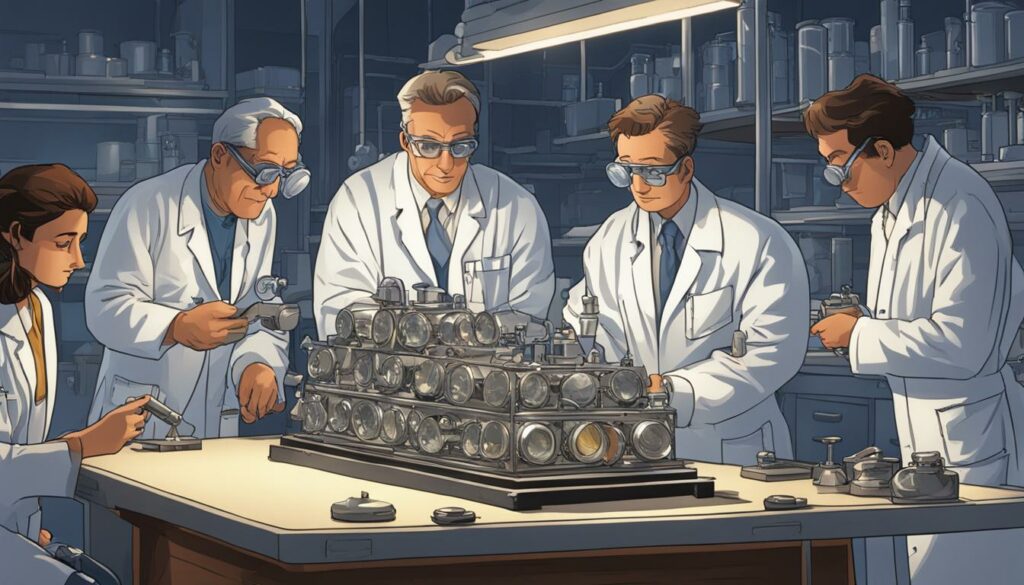
The Benefits of Real Silver
When it comes to choosing jewelry, real silver offers a multitude of benefits that make it a popular choice among consumers. From its durability to its timeless aesthetic, wearing real silver can elevate your style while providing long-lasting beauty. Let’s explore the key advantages of wearing real silver.
Durability
One of the standout qualities of real silver is its exceptional durability. Unlike cheap alternatives, real silver, especially sterling silver, is highly resistant to scratches and tarnishing. Its robust nature allows you to wear your silver jewelry every day without worrying about it losing its shine or becoming damaged. With proper care and maintenance, your real silver pieces can last a lifetime.
Hypoallergenic Properties
If you have sensitive skin or allergies to certain metals, real silver is an excellent choice for you. Unlike fake silver or silver-plated jewelry, which often contains nickel or other allergenic metals, real silver is hypoallergenic. This means it won’t cause irritation, rashes, or discomfort when worn. With real silver, you can enjoy your favorite pieces without any worries about skin reactions.
Timeless Aesthetic
The allure of real silver lies in its classic and timeless aesthetic. Whether you prefer a minimalist look or a bold statement piece, silver jewelry complements any style with its elegant and versatile appeal. From dainty silver necklaces to intricately designed silver bracelets, real silver adds a touch of sophistication and refinement to any outfit. It’s no wonder that real silver has stood the test of time as a beloved choice for jewelry lovers.
| Benefits of Real Silver |
|---|
| Durability |
| Hypoallergenic Properties |
| Timeless Aesthetic |
As you can see, real silver offers numerous advantages that make it a worthwhile investment. Its durability ensures that your jewelry will withstand the test of time, while its hypoallergenic properties make it suitable for those with sensitive skin. Additionally, the timeless aesthetic of real silver adds a touch of elegance to any ensemble. So, whether you’re looking to elevate your personal style or searching for a meaningful gift, real silver is sure to impress with its enduring beauty and charm.
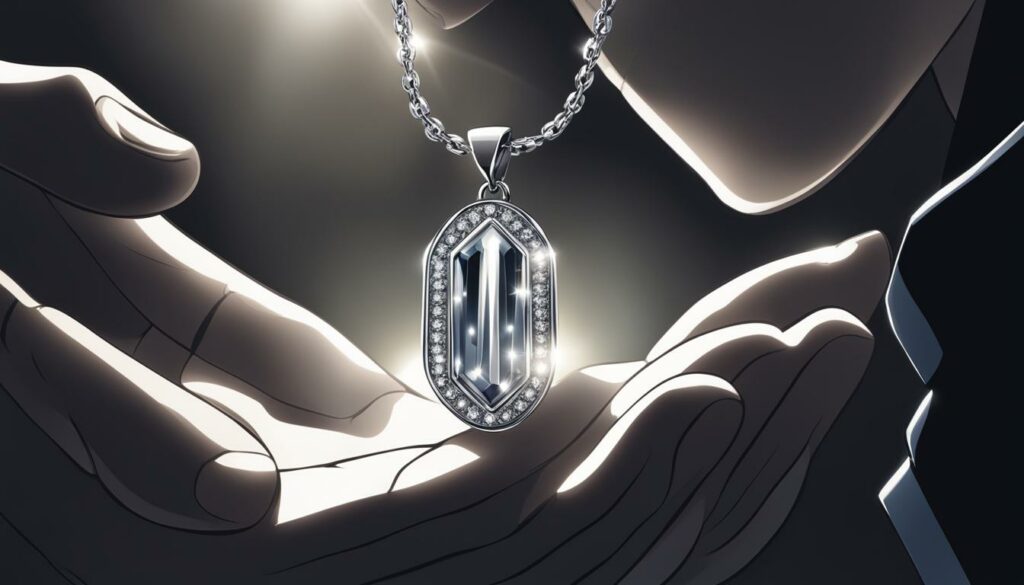
Conclusion
In conclusion, determining the authenticity of your silver is crucial in order to ensure its value and avoid any potential risks. By utilizing the methods and tests outlined in this article, you can confidently identify real silver and differentiate it from fake or counterfeit items.
Remember to look for stamps, markings, and hallmarks that indicate the purity and origin of the silver. Additionally, tests such as the magnet test, ice cube test, and bleach test can provide further evidence of its authenticity. Seeking professional help from jewelry experts or silver appraisers is always a good option if you have any doubts.
Identifying real silver not only allows you to make informed buying or selling decisions but also ensures that you can enjoy the beauty, durability, and hypoallergenic properties that authentic silver offers. So, take the time to test your silver and appreciate the timeless elegance of genuine silver jewelry and items.
FAQ
Are there any specific markings or stamps that indicate the authenticity of silver?
Yes, look for stamps like 925, 900, or 800, which signify the percentage of silver in the piece. Hallmarks such as “STER” for sterling silver or “IS” for international silver can also be indicators of real silver.
Can a magnet be used to determine if silver is real?
Yes, silver is not noticeably magnetic, unlike other metals such as iron or nickel. If a magnet sticks strongly to the silver, it is likely not real silver.
How can I use the ice cube test to determine if my silver is real?
Place an ice cube on the silver. If the ice cube melts rapidly, it is a good indication that the silver is authentic.
Does the bleach test work for determining silver authenticity?
Yes, applying a drop of bleach to the silver should cause it to tarnish or turn black if it is authentic silver. Fake silver or silver-plated items may not have the same reaction to the bleach.
Are there any other tests that can be done to determine if silver is real?
Yes, the sound test involves tapping the silver and listening for a bell-like ringing sound, while the acid test involves using a silver acid test kit to analyze the silver’s purity.
How can I ensure that I’m buying authentic silver?
It is important to buy from credible sources such as quality jewelers. Research the reputation of the seller and look for any certifications or guarantees of authenticity.
How should I care for my silver to keep it in good condition?
Regular polishing and cleaning can help prevent tarnish. Avoid exposing your silver to harsh chemicals or abrasive materials that can damage the surface.
What are the benefits of wearing real silver?
Real silver is durable, hypoallergenic, and has a timeless aesthetic. It can withstand regular wear and tear and is suitable for those with allergies or sensitivities to other metals.
Should I seek professional help if I’m unsure about the authenticity of my silver?
If you are unsure or have valuable silver items, it is best to seek professional help. Experts in jewelry or silver appraisals can provide accurate assessments and evaluations of your silver items.
Source Links
- https://www.thepeachbox.com/blogs/jewelry/how-to-tell-if-silver-is-real
- https://www.marthastewart.com/1541729/how-tell-silver-is-real
- https://www.wikihow.com/Test-Silver

Hey Fashion Enthusiasts! My wife Chantal and I, have been so fortunate to be able to share our latest inspiration and trends in the jewelry and accessory industry, and more so, to get this amazing feedback from our ever growing community. Where my wife focusses more on all things rings, weddings and female jewelry, I love to scoop out the newest accessories for men. I roam around the world to find the latest watches, bags, sunglasses, scarfs, wallets, you name it and I’ll deliver! I always commit to doing a lot of research to share my reviews and personalized advice on this blog or on our store. If you do not know what to wear, send me an email and I will help you out!
